
- We will send in 10–14 business days.
- Author: Timothy W Luke
- Publisher: Duke University Press
- ISBN-10: 0822311232
- ISBN-13: 9780822311232
- Format: 13.7 x 21.3 x 1.9 cm, minkšti viršeliai
- Language: English
- SAVE -10% with code: EXTRA
Reviews
Description
It has long been considered a mark of naïveté to ask of a work of art: What does it say? But as Timothy W. Luke demonstrates in Shows of Force, artwork is capable of saying plenty, and much of the message resides in the way it is exhibited. By critically examining the exhibition of art in contemporary American museums, Luke identifies how art showings are elaborate works of theater that reveal underlying political, social, and economic agendas.
The first section, "Envisioning a Past, Imagining the West," looks at art exhibitions devoted to artworks about or from the American West. Luke shows how these exhibitions-displaying nineteenth- and early-twentieth century works by artists such as George Caleb Bingham, Frederic Remington, Frederic Edwin Church, and Georgia O'Keefe-express contemporary political agendas in the way the portray "the past" and shape new visions of "the West."
In "Developing the Present, Defining a World," Luke considers artists from the post-1945 era, including Ilya Kabokov, Hans Haacke, Sue Coe, Roger Brown, and Robert Longo. Recent art exhibits, his analysis reveals, attempt to develop politically charged conceptions of the present, which in turn struggle to define the changing contemporary world and art's various roles within it.
Luke brings to light the contradictions encoded in the exhibition of art and, in doing so, illuminates the political realities and cultural ideologies of the present. Shows of Force offers a timely and surely controversial contribution to current discussions of the politics of exhibiting art.
EXTRA 10 % discount with code: EXTRA
The promotion ends in 22d.20:39:06
The discount code is valid when purchasing from 10 €. Discounts do not stack.
- Author: Timothy W Luke
- Publisher: Duke University Press
- ISBN-10: 0822311232
- ISBN-13: 9780822311232
- Format: 13.7 x 21.3 x 1.9 cm, minkšti viršeliai
- Language: English English
It has long been considered a mark of naïveté to ask of a work of art: What does it say? But as Timothy W. Luke demonstrates in Shows of Force, artwork is capable of saying plenty, and much of the message resides in the way it is exhibited. By critically examining the exhibition of art in contemporary American museums, Luke identifies how art showings are elaborate works of theater that reveal underlying political, social, and economic agendas.
The first section, "Envisioning a Past, Imagining the West," looks at art exhibitions devoted to artworks about or from the American West. Luke shows how these exhibitions-displaying nineteenth- and early-twentieth century works by artists such as George Caleb Bingham, Frederic Remington, Frederic Edwin Church, and Georgia O'Keefe-express contemporary political agendas in the way the portray "the past" and shape new visions of "the West."
In "Developing the Present, Defining a World," Luke considers artists from the post-1945 era, including Ilya Kabokov, Hans Haacke, Sue Coe, Roger Brown, and Robert Longo. Recent art exhibits, his analysis reveals, attempt to develop politically charged conceptions of the present, which in turn struggle to define the changing contemporary world and art's various roles within it.
Luke brings to light the contradictions encoded in the exhibition of art and, in doing so, illuminates the political realities and cultural ideologies of the present. Shows of Force offers a timely and surely controversial contribution to current discussions of the politics of exhibiting art.


Reviews